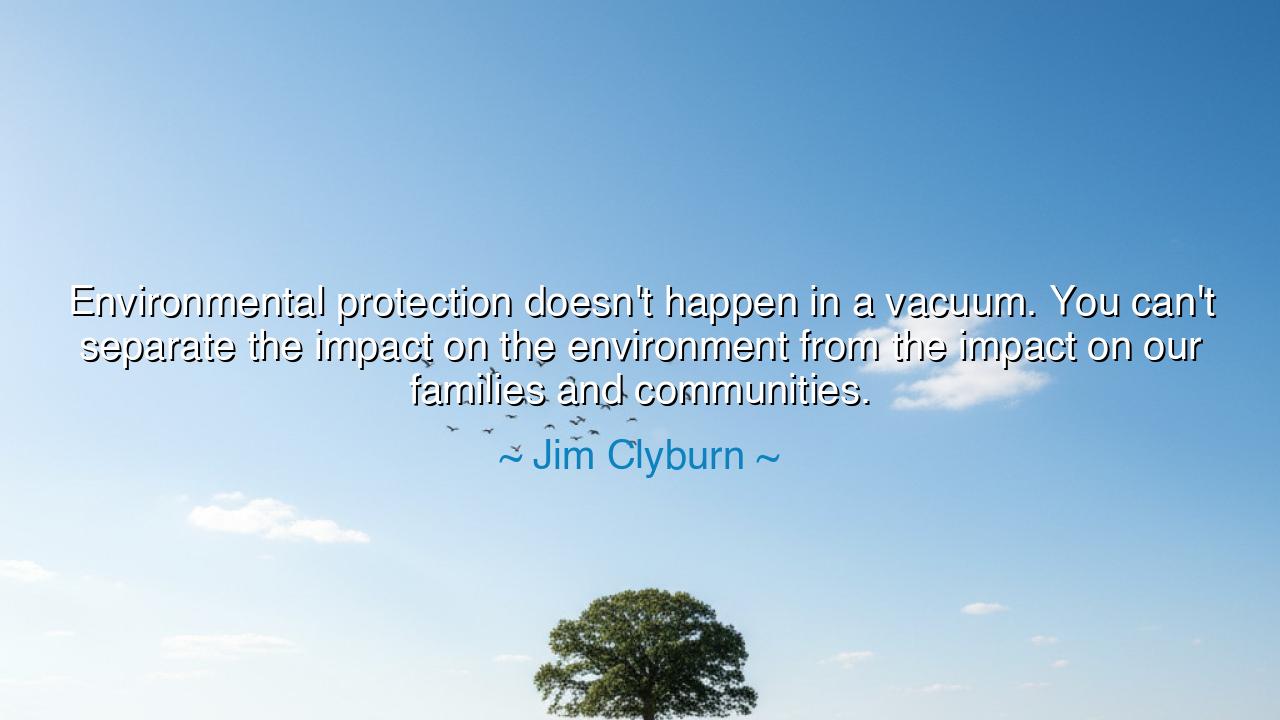
Environmental protection doesn't happen in a vacuum. You can't
Environmental protection doesn't happen in a vacuum. You can't separate the impact on the environment from the impact on our families and communities.






In the counsel of elders, this saying rings like a bell over water: “Environmental protection doesn’t happen in a vacuum. You can’t separate the impact on the environment from the impact on our families and communities.” Thus speaks Jim Clyburn, binding earth and hearth with a single cord. He reminds us that the breath of the child and the breath of the river are not two different winds. If the stream is bitter, the cup at the table is bitter; if the air is heavy, the lungs of the people are heavy. The world is a single room, and what is burned in one corner is smelled in all the others.
The ancients would name this the law of interbeing. Environmental protection is not a hobby for the lonely sage; it is the daily craft of a people who understand that soil becomes bread, and bread becomes laughter—or grief. To imagine a vacuum where policies can be written without faces, or fields can be measured without mothers, is to forget the very purpose of keeping. The forest is not scenery; it is the scaffold of our weather, the teacher of our patience, the dowry of our descendants.
Hear how the proverb splits false choices. Some would say: “Jobs here, clean air there—choose.” But the saying replies: what poisons the creek also thins the payroll, for sickness shortens shifts and blights futures. True environmental care is household economics: fewer hospital nights, steadier work, sturdier homes. When we safeguard the watershed, we are safeguarding the calendar of harvests, the price of groceries, the right of a grandmother to breathe without pain. The impact is one, though its echoes are many.
Consider a story carved into the road of our republic: in 1982, the people of Warren County, North Carolina, rose against the siting of a PCB landfill in their rural, largely Black community. They marched, they lay down on the asphalt, they were arrested by the hundreds. Many called it the birth of the modern environmental justice movement. In their witness, the veil was torn: environmental protection could not be treated as a distant wilderness issue while certain communities were asked to swallow the waste. Policy was forced to look into the eyes of the families it affected. From their defiance came studies, commissions, and at last a national reckoning with how pollution is placed—proving Clyburn’s truth in flesh and history.
Another chapter: the water of Flint, Michigan. Pipes, policy, and penny-counting conspired to turn a city’s lifeblood into a hazard. What some first framed as an infrastructure problem revealed itself as a human calamity—children’s growth, parents’ trust, teachers’ burdens, doctors’ charts—all woven together. There was no vacuum to hide in; the impact on the environment was the impact on the people, immediate and exact. Redemption began only when leaders listened to residents, tested, disclosed, and repaired with the community at the center.
What, then, is the wisdom we hand down? That the circle of care must be drawn wide and drawn near. Measure success not merely by parts per million, but by nights of unbroken sleep, by playgrounds full at dusk, by elders who live to tell long stories. If your environmental protection plan does not ease the burdens of the most burdened families, it is not yet protection—it is a theory without a neighbor.
Take these practices as a simple rule of life: (1) Begin every project with a map of people—who drinks this water, who breathes this air—and let them sit at the table first. (2) Require health impact assessments alongside environmental ones, so the impact on communities is counted in clinics as well as in charts. (3) Train and hire locally for monitoring and restoration; make guardians of those who live closest to the risk. (4) Publish data in plain speech and many languages; secrecy is the enemy of stewardship. (5) Spend where suffering is greatest—replace lead lines, plant shade where heat is harshest, buffer schools from traffic and industry. Do these, and your work will braid river to family, policy to porch, until the land itself seems to breathe easier—because its people do.






AAdministratorAdministrator
Welcome, honored guests. Please leave a comment, we will respond soon